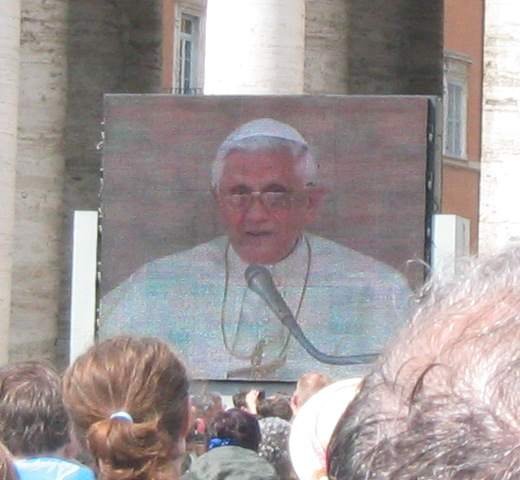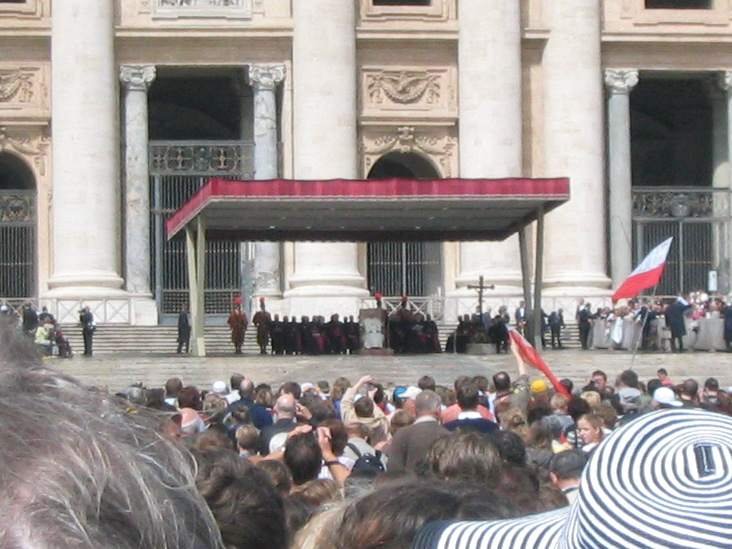
So when I left off my personal story, I was in Rome, on what became a pilgrimage of sorts: enthralled by the majestic churches, captured by the sense of history, drawn to God and Church for the first time in years.
We visited all four major basilicas of Rome: St. John Lateran; St. Mary Major; St. Paul outside the Walls, where I was powerfully moved at St. Paul’s tomb; and St. Peter’s. St. Peter’s in particular was overwhelming in its size and grandeur. I found the tomb of St. Gregory the Great, who was one of my favorite saints even then; and I’ve already told of my wonderings about St. Peter’s tomb. Some of the other churches we visited included San Clemente, the oldest of any church we saw, whose foundations reached back to the first century; Santa Maria sopra Minerva, where lay interred St. Catherine of Siena; and Santa Maria degli Angeli e dei Martiri, built in the remains of the Baths of Diocletian. There is far more to tell of my time in Rome, and far more still that I failed to see for my closed spiritual eyes. I long to go back now that I’ve found the Church.

One more anecdote about Rome that I’d like to relate: I saw the pope. As I related briefly before, Pope John Paul II had died only weeks before our trip, and Pope Benedict XVI had succeeded him. Pope Benedict had only just taken possession of St. John Lateran as cathedral of Rome the week of our visit. (Many people don’t realize that St. John Lateran, not St. Peter’s, is Rome’s cathedral church.) I was very sad at the passing of Pope John Paul, but I was glad, at least, that he was no longer suffering, and that I might have the chance to see the new pope.
Every Wednesday, the pope holds a General Audience in St. Peter’s Square. A group of my fellow students and I decided to attend. It was an overcast Wednesday morning when we set out, five or six of us, from our hotel — without umbrellas. It wasn’t very long before we regretted that lack of foresight. It came a downpour, and by the time we arrived at St. Peter’s Square and had been sitting there a few minutes waiting, we were soaked to the bone. Gradually the rain slackened to a drizzle, but it was still overcast and unpleasant.
Finally the time came for the pope to appear. He rolled out at one end of the piazza in his pope-mobile, to the cheers of the people greeting their new pontiff. Two giant projection-screen TVs broadcast his arrival for those of us sitting at a distance. He circled the square, waving to the faithful, before coming to the stage erected on the steps of the basilica, and exiting.
The pope stepped out onto the steps, and raised his arms in a blessing. At that moment, the clouds parted. The sun appeared, brightly and warmly. The rain stopped. It was as if God was smiling on this man and on us who had come to hear him.
He spoke for a few minutes. I suppose he was speaking Italian, since I don’t remember what he said. But I felt very glad just to be there, to be standing a mere few yards away from the leader of Western Christendom.
At the end of his address, he said a blessing over the people, and announced that all religious items brought to the square that day were now blessed. I suppose many of the Catholic faithful brought Rosaries, statues, icons, and other devotional objects. I happened to have a Bible in my backpack, a compact NIV my dad had bought for me before I left. It is a religious item, I thought. I considered it ironic that the pope had unknowingly blessed a Protestant translation of the Bible; but I nonetheless considered it meaningful and important. I inscribed the event on the frontispiece of the book, and have cherished it ever since as “the Pope’s Bible.”
As soon as the pope was done speaking and had left the stage, the rain resumed. The clouds returned to cover the sun. I considered it an amusing coincidence, and have often jovially told the story, as I am now — but looking back I see the experience as yet another subtle gesture from God to the authority of this man and this Church — a nod as if to say, I am looking after this foundation. Looking back over the years, through all that I traveled, I consider it no small matter that the pope of Rome prayed for me and said words of blessing over me: At very long last, after seven years, those words have brought me home.



Learned something new–I didn’t know that St. John Lateran was Rome’s cathedral. I just assumed it was St. Peter’s. What is St. Peter’s in relation to everything else, then?
The Lateran is the cathedral by virtue of being the oldest. It was the first basilica that the emperor Constantine donated to the Church (and the Lateran Palace with it), before he built St. Peter’s. I guess it’s by tradition that it has remained the cathedral, even though in most unofficial senses, St. Peter’s has become the “capital” basilica of the Church. St. Peter’s is the largest of any other church by far (by design — there have been attempts by wealthy patrons to build larger churches in various places, but the popes put the smackdown on them), and the Vatican is where the pope and most of the bureaucracy of the Church lives now. And of course, St. Peter’s tomb is there. St. Peter’s actually has a cathedra, too — but it’s not actually the pope’s cathedra.
Thanks, that’s helpful. And at one time, I used to know the difference between a basilica and a cathedral–is it a difference of size, or function, or just naming?
“Basilica,” at least historically, refers to the architectural style. Basilicas were public buildings in Rome before they were churches (in Greek it refers to a royal hall; in Rome they were usually used as seats of courts and tribunals). I guess there are some especially grand churches today that take that title without actually having a basilica layout. A cathedral is any church where the bishop of the diocese has his seat (literally a chair or cathedra).
I LOVE it! You have an NIV blessed by the pope! 🙂
That just tickles me!